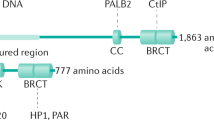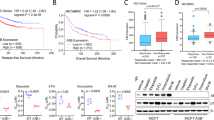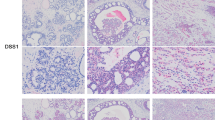Abstract
BRCA1 mediates resistance to apoptosis in response to DNA-damaging agents, causing BRCA1 wild-type tumours to be significantly more resistant to DNA damage than their mutant counterparts. In this study, we demonstrate that following treatment with the DNA-damaging agents, etoposide or camptothecin, BRCA1 is required for the activation of nuclear factor-κB (NF-κB), and that BRCA1 and NF-κB cooperate to regulate the expression of the NF-κB antiapoptotic targets BCL2 and XIAP. We show that BRCA1 and the NF-κB subunit p65/RelA associate constitutively, whereas the p50 NF-κB subunit associates with BRCA1 only upon DNA damage treatment. Consistent with this BRCA1 and p65 are present constitutively on the promoters of BCL2 and XIAP, whereas p50 is recruited to these promoters only in damage treated cells. Importantly, we demonstrate that the recruitment of p50 onto the promoters of BCL2 and XIAP is dependent upon BRCA1, but independent of its NF-κB partner subunit p65. The functional relevance of NF-κB activation by BRCA1 in response to etoposide and camptothecin is demonstrated by the significantly reduced survival of BRCA1 wild-type cells upon NF-κB inhibition. This study identifies a novel BRCA1–p50 complex, and demonstrates for the first time that NF-κB is required for BRCA1-mediated resistance to DNA damage. It reveals a functional interdependence between BRCA1 and NF-κB, further elucidating the role played by NF-κB in mediating cellular resistance of BRCA1 wild-type tumours to DNA-damaging agents.
This is a preview of subscription content, access via your institution
Access options
Subscribe to this journal
Receive 50 print issues and online access
$259.00 per year
only $5.18 per issue
Buy this article
- Purchase on Springer Link
- Instant access to full article PDF
Prices may be subject to local taxes which are calculated during checkout







Similar content being viewed by others
References
Huen MS, Sy SM, Chen J . BRCA1 and its toolbox for the maintenance of genome integrity. Nat Rev Mol Cell Biol 2010; 11: 138–148.
Mullan PB, Quinn JE, Harkin DP . The role of BRCA1 in transcriptional regulation and cell cycle control. Oncogene 2006; 25: 5854–5863.
Roy R, Chun J, Powell SN . BRCA1 and BRCA2: different roles in a common pathway of genome protection. Nat Rev Cancer 2012; 12: 68–78.
Mullan PB, Gorski JJ, Harkin DP . BRCA1—a good predictive marker of drug sensitivity in breast cancer treatment? Biochim Biophys Acta 2006; 1766: 205–216.
Quinn JE, Kennedy RD, Mullan PB, Gilmore PM, Carty M, Johnston PG et al. BRCA1 functions as a differential modulator of chemotherapy-induced apoptosis. Cancer Res 2003; 63: 6221–6228.
Treszezamsky AD, Kachnic LA, Feng Z, Zhang J, Tokadjian C, Powell SN . BRCA1- and BRCA2-deficient cells are sensitive to etoposide-induced DNA double-strand breaks via topoisomerase II. Cancer Res 2007; 67: 7078–7081.
Farmer H, McCabe N, Lord CJ, Tutt AN, Johnson DA, Richardson TB et al. Targeting the DNA repair defect in BRCA mutant cells as a therapeutic strategy. Nature 2005; 434: 917–921.
Quinn JE, James CR, Stewart GE, Mulligan JM, White P, Chang GK et al. BRCA1 mRNA expression levels predict for overall survival in ovarian cancer after chemotherapy. Clin Cancer Res 2007; 13: 7413–7420.
Hartman AR, Ford JM . BRCA1 induces DNA damage recognition factors and enhances nucleotide excision repair. Nat Genet 2002; 32: 180–184.
Harkin DP, Bean JM, Miklos D, Song YH, Truong VB, Englert C et al. Induction of GADD45 and JNK/SAPK-dependent apoptosis following inducible expression of BRCA1. Cell 1999; 97: 575–586.
Hosey AM, Gorski JJ, Murray MM, Quinn JE, Chung WY, Stewart GE et al. Molecular basis for estrogen receptor alpha deficiency in BRCA1-linked breast cancer. J Natl Cancer Inst 2007; 99: 1683–1694.
Kennedy RD, Gorski JJ, Quinn JE, Stewart GE, James CR, Moore S et al. BRCA1 and c-Myc associate to transcriptionally repress psoriasin, a DNA damage-inducible gene. Cancer Res 2005; 65: 10265–10272.
Mullan PB, Hosey AM, Buckley NE, Quinn JE, Kennedy RD, Johnston PG et al. The 2,5 oligoadenylate synthetase/RNaseL pathway is a novel effector of BRCA1- and interferon-gamma-mediated apoptosis. Oncogene 2005; 24: 5492–5501.
Gorski JJ, Savage KI, Mulligan JM, McDade SS, Blayney JK, Ge Z et al. Profiling of the BRCA1 transcriptome through microarray and ChIP-chip analysis. Nucleic Acids Res 2011; 39: 9536–9548.
Benezra M, Chevallier N, Morrison DJ, MacLachlan TK, El-Deiry WS, Licht JD . BRCA1 augments transcription by the NF-kappaB transcription factor by binding to the Rel domain of the p65/RelA subunit. J Biol Chem 2003; 278: 26333–26341.
Bochar DA, Wang L, Beniya H, Kinev A, Xue Y, Lane WS et al. BRCA1 is associated with a human SWI/SNF-related complex: linking chromatin remodeling to breast cancer. Cell 2000; 102: 257–265.
Harte MT, O'Brien GJ, Ryan NM, Gorski JJ, Savage KI, Crawford NT et al. BRD7, a subunit of SWI/SNF complexes, binds directly to BRCA1 and regulates BRCA1-dependent transcription. Cancer Res 2010; 70: 2538–2547.
Hayden MS, Ghosh S . Shared principles in NF-kappaB signaling. Cell 2008; 132: 344–362.
Perkins ND . Integrating cell-signalling pathways with NF-kappaB and IKK function. Nat Rev Mol Cell Biol 2007; 8: 49–62.
Stilmann M, Hinz M, Arslan SC, Zimmer A, Schreiber V, Scheidereit C . A nuclear poly(ADP-ribose)-dependent signalosome confers DNA damage-induced IkappaB kinase activation. Mol Cell 2009; 36: 365–378.
Sabatel H, Pirlot C, Piette J, Habraken Y . Importance of PIKKs in NF-kappaB activation by genotoxic stress. Biochem Pharmacol 2011; 82: 1371–1383.
McCool KW, Miyamoto S . DNA damage-dependent NF-kappaB activation: NEMO turns nuclear signaling inside out. Immunol Rev 2012; 246: 311–326.
Habraken Y, Piette J . NF-kappaB activation by double-strand breaks. Biochem Pharmacol 2006; 72: 1132–1141.
Wang J, Jacob NK, Ladner KJ, Beg A, Perko JD, Tanner SM et al. RelA/p65 functions to maintain cellular senescence by regulating genomic stability and DNA repair. EMBO Rep 2009; 10: 1272–1278.
Volcic M, Karl S, Baumann B, Salles D, Daniel P, Fulda S et al. NF-kappaB regulates DNA double-strand break repair in conjunction with BRCA1-CtIP complexes. Nucleic Acids Res 2012; 40: 181–195.
Gorski JJ, James CR, Quinn JE, Stewart GE, Staunton KC, Buckley NE et al. BRCA1 transcriptionally regulates genes associated with the basal-like phenotype in breast cancer. Breast Cancer Res Treat 2010; 122: 721–731.
Freneaux P, Stoppa-Lyonnet D, Mouret E, Kambouchner M, Nicolas A, Zafrani B et al. Low expression of bcl-2 in Brca1-associated breast cancers. Br J Cancer 2000; 83: 1318–1322.
McEachern KA, Archey WB, Douville K, Arrick BA . BRCA1 splice variants exhibit overlapping and distinct transcriptional transactivation activities. J Cell Biochem 2003; 89: 120–132.
Barre B, Perkins ND . A cell cycle regulatory network controlling NF-kappaB subunit activity and function. EMBO J 2007; 26: 4841–4855.
Habraken Y, Jolois O, Piette J . Differential involvement of the hMRE11/hRAD50/NBS1 complex, BRCA1 and MLH1 in NF-kappaB activation by camptothecin and X-ray. Oncogene 2003; 22: 6090–6099.
Schumm K, Rocha S, Caamano J, Perkins ND . Regulation of p53 tumour suppressor target gene expression by the p52 NF-kappaB subunit. EMBO J 2006; 25: 4820–4832.
Chappuis PO, Goffin J, Wong N, Perret C, Ghadirian P, Tonin PN et al. A significant response to neoadjuvant chemotherapy in BRCA1/2 related breast cancer. J Med Genet 2002; 39: 608–610.
Kirova YM, Stoppa-Lyonnet D, Savignoni A, Sigal-Zafrani B, Fabre N, Fourquet A . Risk of breast cancer recurrence and contralateral breast cancer in relation to BRCA1 and BRCA2 mutation status following breast-conserving surgery and radiotherapy. Eur J Cancer 2005; 41: 2304–2311.
Nakanishi C, Toi M . Nuclear factor-kappaB inhibitors as sensitizers to anticancer drugs. Nat Rev Cancer 2005; 5: 297–309.
Perkins ND . The diverse and complex roles of NF-kappaB subunits in cancer. Nat Rev Cancer 2012; 12: 121–132.
DiDonato JA, Mercurio F, Karin M . NF-kappaB and the link between inflammation and cancer. Immunol Rev 2012; 246: 379–400.
Franken NA, Rodermond HM, Stap J, Haveman J, van Bree C . Clonogenic assay of cells in vitro. Nat Protoc 2006; 1: 2315–2319.
Acknowledgements
We thank Dr Stephen McMahon for help with statistical analysis of survival curves. This study was supported by Medical Research Council (M.T Harte and D.P Harkin); Cancer Research UK (KI Savage, JJ Gorski, P Burn, E Barros and DP Harkin); Cancer Focus Northern Ireland (KI Savage); Action Cancer (J.P Purcell).
Author information
Authors and Affiliations
Corresponding authors
Ethics declarations
Competing interests
The authors declare no conflict of interest.
Additional information
Supplementary Information accompanies the paper on the Oncogene website
Supplementary information
Rights and permissions
About this article
Cite this article
Harte, M., Gorski, J., Savage, K. et al. NF-κB is a critical mediator of BRCA1-induced chemoresistance. Oncogene 33, 713–723 (2014). https://doi.org/10.1038/onc.2013.10
Received:
Revised:
Accepted:
Published:
Issue Date:
DOI: https://doi.org/10.1038/onc.2013.10
Keywords
This article is cited by
-
BRCA mutations lead to XIAP overexpression and sensitise ovarian cancer to inhibitor of apoptosis (IAP) family inhibitors
British Journal of Cancer (2022)
-
Possible mechanisms underlying the association between human T-cell leukemia virus type 1 (HTLV-1) and hypertension in elderly Japanese population
Environmental Health and Preventive Medicine (2021)
-
p50 mono-ubiquitination and interaction with BARD1 regulates cell cycle progression and maintains genome stability
Nature Communications (2020)
-
Potential mechanisms underlying the association between single nucleotide polymorphism (BRAP and ALDH2) and hypertension among elderly Japanese population
Scientific Reports (2020)
-
MicroRNAs, DNA damage response and ageing
Biogerontology (2020)



